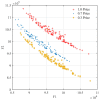Emergency Relief Chain for Natural Disaster Response Based on Government-Enterprise Coordination
- PMID: 36141522
- PMCID: PMC9517505
- DOI: 10.3390/ijerph191811255
Emergency Relief Chain for Natural Disaster Response Based on Government-Enterprise Coordination
Abstract
Public health and effective risk response cannot be promoted without a coordinated emergency process during a natural disaster. One primary problem with the emergency relief chain is the homogeneous layout of rescue organizations and reserves. There is a need for government-enterprise coordination to enhance the systemic resilience and demand orientation. Therefore, a bi-level multi-phase emergency plan model involving procurement, prepositioning and allocation is proposed. The tradeoff of efficiency, economy and fairness is offered through the multi-objective cellular genetic algorithm (MOCGA). The flood emergency in Hunan Province, China is used as a case study. The impact of multi-objective and coordination mechanisms on the relief chain is discussed. The results show that there is a significant boundary condition for the coordinated location strategy of emergency facilities and that further government coordination over the transition phase can generate optimal relief benefits. Demand orientation is addressed by the proposed model and MOCGA, with the realization of the process coordination in multiple reserves, optimal layout, and transition allocation. The emergency relief chain based on government-enterprise coordination that adapts to the evolution of disasters can provide positive actions for integrated precaution and health security.
Keywords: emergency relief chain; government-enterprise; process coordination; transition allocation.
Conflict of interest statement
The authors declare no conflict of interest.
Figures
















Similar articles
-
Multiobjective Emergency Resource Allocation under the Natural Disaster Chain with Path Planning.Int J Environ Res Public Health. 2022 Jun 27;19(13):7876. doi: 10.3390/ijerph19137876. Int J Environ Res Public Health. 2022. PMID: 35805533 Free PMC article.
-
Construction of Urban Flood Disaster Emergency Management System Using Scenario Construction Technology.Comput Intell Neurosci. 2022 Mar 15;2022:8048327. doi: 10.1155/2022/8048327. eCollection 2022. Comput Intell Neurosci. 2022. Retraction in: Comput Intell Neurosci. 2023 Aug 9;2023:9807606. doi: 10.1155/2023/9807606. PMID: 35330597 Free PMC article. Retracted.
-
The German approach to emergency/disaster management.Med Arh. 2000;54(4):201-3. Med Arh. 2000. PMID: 11117024
-
Remote Sensing Methods for Flood Prediction: A Review.Sensors (Basel). 2022 Jan 26;22(3):960. doi: 10.3390/s22030960. Sensors (Basel). 2022. PMID: 35161706 Free PMC article. Review.
-
Medical rehabilitation in disaster relief: Towards a new perspective.J Rehabil Med. 2017 Aug 31;49(8):620-628. doi: 10.2340/16501977-2250. J Rehabil Med. 2017. PMID: 28665445 Review.
Cited by
-
Constructing an emergency preparedness evaluation index system for public use during major emerging infectious disease outbreaks: a Delphi study.BMC Public Health. 2023 Jun 8;23(1):1109. doi: 10.1186/s12889-023-15980-6. BMC Public Health. 2023. PMID: 37291522 Free PMC article. Review.
-
Multi-scenario flexible contract coordination for determining the quantity of emergency medical suppliers in public health events.Front Public Health. 2024 Mar 20;12:1334583. doi: 10.3389/fpubh.2024.1334583. eCollection 2024. Front Public Health. 2024. PMID: 38572003 Free PMC article.
-
Coping with drug shortages: A study of government-enterprise option cooperation stockpiling strategies for drugs in shortage considering API surrogate stockpiling subsidies.PLoS One. 2024 Jul 2;19(7):e0305383. doi: 10.1371/journal.pone.0305383. eCollection 2024. PLoS One. 2024. PMID: 38954737 Free PMC article.
-
Study on the logic and effectiveness of crisis learning in the promotion policy adjustment: an observation based on the adjustment of COVID-19 prevention policy in China.Front Public Health. 2024 Jan 5;11:1324420. doi: 10.3389/fpubh.2023.1324420. eCollection 2023. Front Public Health. 2024. PMID: 38249403 Free PMC article.
References
-
- Mavhura E. Learning from the tropical cyclones that ravaged Zimbabwe: Policy implications for effective disaster preparedness. Nat. Hazards. 2020;104:2261–2275. doi: 10.1007/s11069-020-04271-7. - DOI
-
- UNDRR Disasters Displace More People than Conflict and Violence. [(accessed on 3 August 2022)]. Available online: https://www.undrr.org/news/disasters-displace-more-people-conflict-and-v....
-
- Ergun Ö., Gui L., Heier Stamm J.L., Keskinocak P., Swann J. Improving humanitarian operations through technology-enabled collaboration. Prod. Oper. Manag. 2014;23:1002–1014. doi: 10.1111/poms.12107. - DOI
-
- Horney J., Nguyen M., Salvesen D., Tomasco O., Berke P. Engaging the public in planning for disaster recovery. Int. J. Disaster Risk Reduct. 2016;17:33–37. doi: 10.1016/j.ijdrr.2016.03.011. - DOI
-
- UNDRR Sendai Framework for Disaster Risk Reduction 2015–2030. [(accessed on 1 September 2022)]. Available online: https://www.undrr.org/implementing-sendai-framework/what-sendai-framework.
Publication types
MeSH terms
LinkOut - more resources
Full Text Sources
Medical

